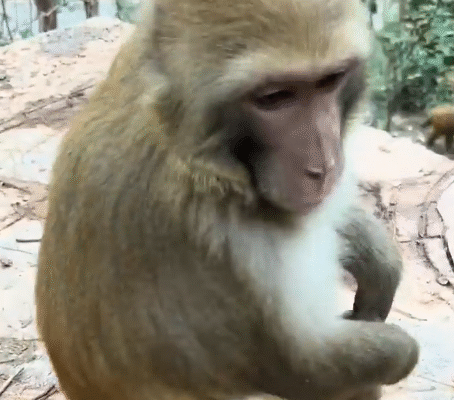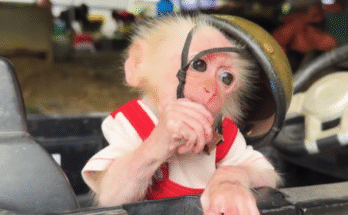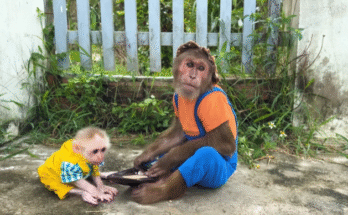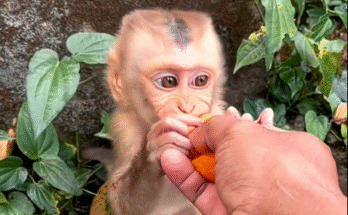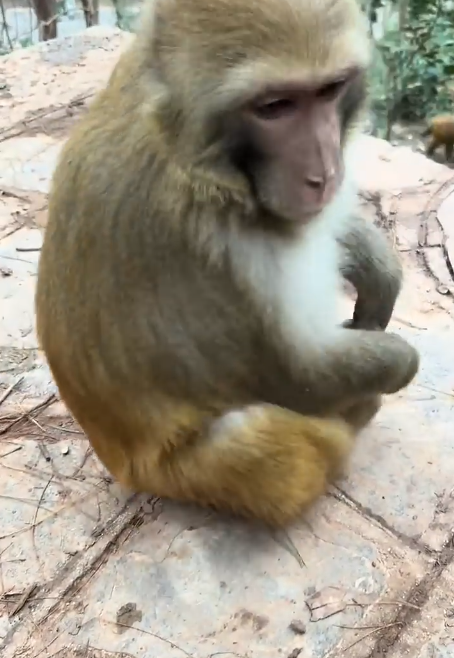
The village at the edge of the jungle was quiet that morning, the kind of stillness that always feels like it’s holding its breath. Birds called softly to one another, and the wind whispered through the trees, carrying the smell of wet earth and fresh leaves. But in the middle of the village square, chaos was quietly unfolding—a small, mischievous monkey had been caught in a net trap, and everyone was unsure how to handle it.
The monkey was tiny, brown-furred, with bright, sparkling eyes that darted nervously from face to face. Its tail twitched constantly, and its hands gripped the rope desperately. It squeaked, high-pitched and urgent, as if it were trying to communicate something important, but no one seemed to understand. The villagers circled, murmuring anxiously. Some wanted to untie the trap immediately, while others argued that the monkey was dangerous and should be kept away.
At that moment, an elderly woman stepped forward. Her hair was silver, her eyes warm yet sharp, and she carried an air of quiet authority. The villagers had always respected her for her knowledge of the jungle and its creatures. “Listen carefully,” she said, her voice calm but firm. “Let the monkey go.”
The villagers exchanged confused glances. “But it’s caught! What if it attacks?” someone asked nervously.
The elderly woman shook her head slowly. “You must understand. The monkey is frightened, yes, but it is not cruel. It only acts out of instinct. If you listen carefully, you will understand what it needs. Only then will you know what to do.”
The villagers hesitated, unsure whether to follow her advice. But something in her gaze—calm, unwavering—made them step back, giving the monkey some space. They began to watch, quietly and attentively.
The monkey, sensing the change in energy, stopped struggling for a moment. Its tiny hands loosened their grip on the rope, and it tilted its head to the side, eyes flicking around. Then it made a soft, almost melodic squeak. It was not a scream, not a cry of anger, but something different—a sound that seemed to convey curiosity, fear, and a plea for understanding all at once.
The villagers leaned in, listening carefully. One of the children whispered, “It sounds like it’s asking us for help.”
“Exactly,” the elderly woman said. “The monkey doesn’t want to be harmed. It wants freedom. You must respect that.”
One by one, the villagers began to realize the truth in her words. The monkey was not a nuisance; it was a living, intelligent being, frightened by its situation and relying on those around it to respond with care. Panic or force would only make things worse. What it needed was patience, observation, and empathy.
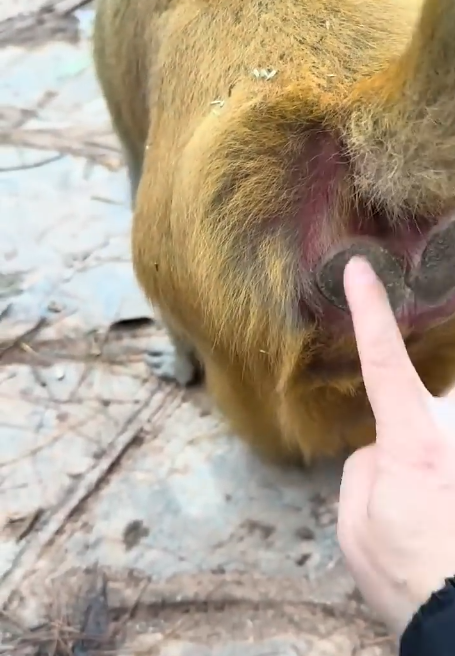
Slowly, one of the men stepped forward, holding out his hands in a gentle gesture. The monkey froze, staring at him intently. Then, in a surprising display of trust, it reached out with one tiny hand, brushing against his fingers. The man didn’t move quickly or try to grab it. Instead, he remained calm, letting the monkey decide how close it wanted to be.
The elderly woman nodded approvingly. “Good. Listen to it. Feel what it is telling you. The rest will follow.”
As the villagers continued to watch, they noticed subtle movements: the monkey shifting its weight, twitching its ears, and even vocalizing softly in a rhythm that almost resembled words. It was as if the creature was giving instructions—not in human language, but in body language and sound. It wanted freedom, yes, but it also seemed to want assurance that it would not be harmed, that it would be understood.
Another villager, braver than the rest, slowly untied one corner of the net. The monkey froze, then squeaked softly, almost as if saying, “Careful… slowly… gently…” Encouraged by its response, the man continued untying, each knot released with patience. The monkey shifted slightly, its tiny eyes bright with cautious hope.
Minutes passed, and the villagers held their breath. Finally, the last knot was loosened. The monkey paused, looking around as if checking that everything was safe, and then, with a graceful leap, it sprang free from the trap. For a moment, it hung in the air, tail curled, hands reaching for balance, before landing softly on a nearby branch.
The villagers exhaled collectively, relief and awe mingling in the air. The monkey didn’t run immediately; instead, it turned to look back at them, eyes sparkling, and made a series of soft squeaks that sounded almost like a laugh. It was a moment of mutual recognition: they had listened, understood, and allowed the monkey to reclaim its freedom.
The elderly woman smiled. “Do you see? You didn’t need to force or frighten it. You simply had to listen carefully and respect its needs. That is the way of the jungle. That is the way of all living beings.”
The villagers nodded, humbled by the lesson. They realized that in their rush to act—sometimes driven by fear, sometimes by misunderstanding—they had almost caused harm. But by slowing down, observing, and listening, they had achieved something far greater: trust, empathy, and the preservation of life.
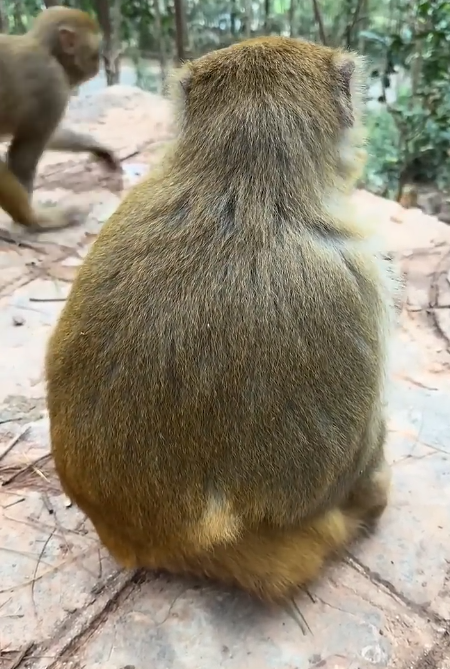
The monkey, now perched safely on a higher branch, began grooming itself, flicking its tail with satisfaction. Then, almost playfully, it made a tiny leap toward a nearby tree, paused, and looked back again. It was as if to say, “Thank you. I am free, and I remember who helped me.”
The children laughed quietly, enchanted by the monkey’s playful demeanor. One whispered, “It’s like it’s smiling at us!”
The elderly woman nodded. “Yes. Animals communicate in ways we often overlook. If we take the time to listen, we can understand them better than words ever allow.”
For the rest of the day, the story of the monkey spread through the village. People recounted how the little creature had been trapped, how everyone had gathered, and how patience, listening, and understanding had allowed it to go free. Parents used the story to teach their children about empathy, responsibility, and respect for all living beings. Even the adults found themselves reflecting on the lesson: sometimes, it is not force or speed that solves problems, but careful observation, patience, and willingness to listen.
That evening, as the sun dipped low and the forest canopy glowed golden, the villagers returned to their homes, still talking quietly about the monkey. Somewhere in the trees above, the little creature swung from branch to branch, free once more, playful and cautious, carrying with it the memory of kindness and respect.
The lesson lingered long after the monkey had disappeared from sight: listen carefully and let the monkey go. It was a principle that applied not only to animals but to life itself. Patience, observation, and empathy could resolve conflicts, heal fears, and foster trust in ways that force or haste never could.
And in that moment, the jungle felt alive not just with movement, but with understanding. The monkey had returned to its world, and the villagers had learned a timeless truth: sometimes, the wisest action is the quietest one, the action of listening, respecting, and letting go.
The little monkey, though small and seemingly ordinary, had taught the village a lesson that would echo for generations: freedom, trust, and life itself are gifts that flourish when approached with care, attention, and love. And if one listens carefully, truly listens, even the smallest voice can guide the way. 🤭
